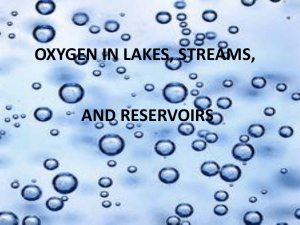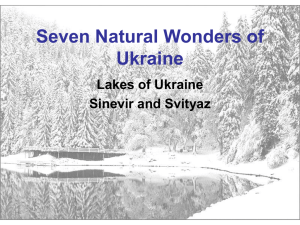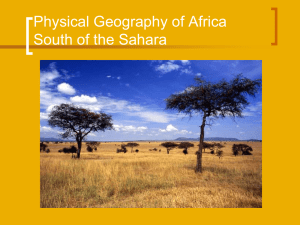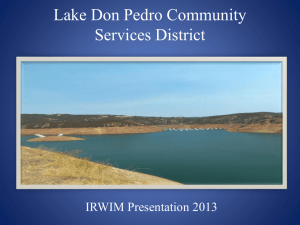Balkash basin of Kazakhstan - Asian G-WADI
advertisement
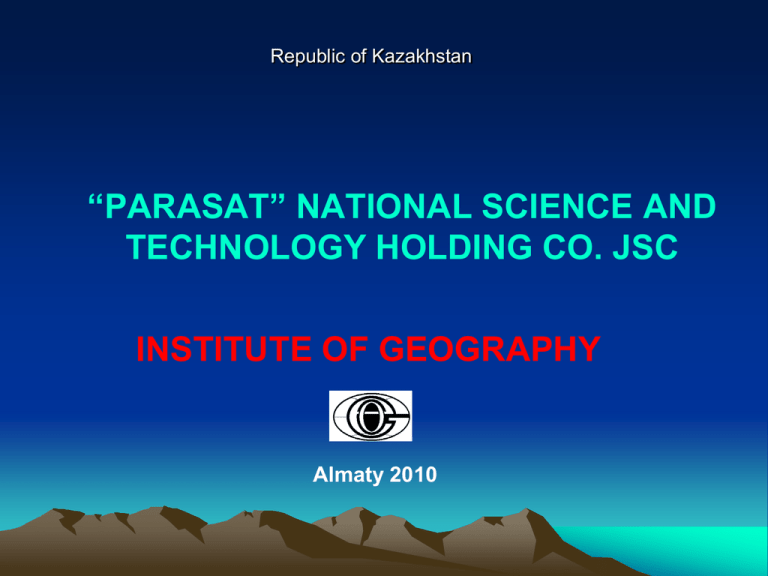
Republic of Kazakhstan “PARASAT” NATIONAL SCIENCE AND TECHNOLOGY HOLDING CO. JSC INSTITUTE OF GEOGRAPHY Almaty 2010 Balkash basin Republic of Kazakhstan Republic of Kazakhstan is the least water delivery in the States of Central Asia. The peculiarity of the surface waters of the Republic is nearly half of the river that enters to the country from the territory of neighboring states. At the present level of knowledge of surface water runoff of all rivers in Kazakhstan is estimated at 100,5 км3 per year. Of which 56.5 km3 formed on the territory of the republic and 44.0 km3, in neighboring countries. At the same from China received an average of 19,9, Uzbekistan13,7, Russia 7,4 Kyrgyzstan 3,0 км3 In the long term is expected to reduce cross-border flow of resources into the country in connection with business activities in China,Russia, Uzbekistan,Kyrgyzstan. An additional threat to sustainable water supply of the republic creates a likely decrease in the local runoff, due to global and regional climate change The turquoise waters of Lake Balkhash can be seen in this northeast-looking, high-oblique photograph. The lake covering 6560 square miles (17 000 square kilometers), is nearly 350 miles (565 kilometers) long, but at this time is only 45 miles (72 kilometers) at its maximum width. The average depth of Lake Balkhash is 20 feet (6 meters), but the lake reaches a maximum depth of 85 feet (26 meters) in its western half. Lake Balkhash extends from the Betpak Steppe in the west to the Kazakh Hills in the northeast. Visible in the photograph to the north of the lake is a vast undulating plain, and southsoutheast of the lake are the Ili River and its delta. The Ili River separates two deserts. The larger, sandy Sary-Ishikotrau Desert lies northeast of the Ili River. A much smaller river, the Karatal, traverses this desert and empties into the eastern portion of Lake Balkhash. The Taukum Desert (brownish color) can be seen southwest of the Ili River. A large sandbar or spit (center of the photograph) separates the eastern, shallower, more saline part of Lake Balkhash from the deeper, fresher water of the western portion of the lake. The Ili River is fed by melting snow and glaciers of the Tien Shan ranges in China south of the lake (not visible in the photograph). Lake Balkhash has no river outlet and, even with the influx of fresh water from the Ili River, is shrinking because of evaporation; however, its rate of shrinkage is much less than that of the Aral Sea, which juts into Kazakhstan much farther to the west. Republic of Kazakhstan Aral Sea • Runoff from fields in the middle and lower reaches of the Syr darya and Amudarya rivers caused deposits of various pesticides and other agricultural chemicals that appear in some places by 54 km ² of former seabed covered with salt. Dust storms are spreading salt, dust and chemicals at a distance of 500 km. They are carried by air and destroy or retard the development of natural vegetation and agricultural crops. The local population suffers from high incidence of respiratory diseases, anemia, cancer of the larynx and esophagus, as well as digestive disorders. Is becoming more diseases of the liver and kidney failure, eye disease. Aral Sea The dam also provided recharge the northern part of the Aral Sea, and as a result of the water began to return. According to Kazakh officials, the sea is already recovered to 40%. Fishermen took up fishing again. this area became precipitation again. Lake Balkash 633 × 552 pixels, file size: 68 KB, MIME-type: image / jpeg) View of Lake Balkash from space Snapshot NASA, August 2002 • Numerals indicate the largest peninsula of the island and bays: Saryesik Peninsula, separating the lake into two parts, and the Strait of Uzynaral Peninsula Baygabyl Peninsula Balai Peninsula Shaukar Peninsula Kentubek Islands Basaran and Ortaaral Island Tasaral Bay Shempek Bay Saryshagan Water problems of Balkash Basin Threats and Challenges Climatic dependence melting The rising costs of river of mountain glaciers,reduction runoff in China to 4.9 km 3 / year in resources and change regime reducing transboundary hectare of river flow to 12,0-10,6 km 3 / year Ile to 11.4 km 3 / year Water hazard Reduction of potential resources poverhnostnyhVod Republic up to 16-19 km 3 / godpri natural resources 29 km 3 / year Drying and salinization of the lake Balkash and desertification delta Ile at the reduction influx of up to 10-12 km 3 / year The emergence of a new hotbed Environmental instability in Pribalkashe Increased frequency and intensity of catastrophic hydrological events, mudflows. avalanches Material damage and casualties in impact Areas natural phenomena Reduced runoff for agricultural to 4,5-2,0 km 3 / year Disruption of the program Prodolstvennogo self-reliance of the region in the reduction of irrigated land Streamflow resources of Balkash Basin In semi-natural resources during the runoff basin amounted to 29.36 km 3 / year, of which the PRC was formed 16,05 km 3 / year, in Kazakhstan, 13,31 km 3 / year. Cost of runoff in China amounted to 4.6 km 3 / year, including domestic water consumption and natural losses, in Kazakhstan, 9.65 km 3 / year, the lake received Balkash 15,11 km 3 / year. 10 per cent reduction of climatic resources of river runoff to 26.40 km 3 / year and increasing the cost of runoff in China to 7.4 km 3 / year, the disposable resources of RK runoff decreased to 19 km 3 / year, including for the lake BalkashN km3/year. With a 20-percent reduction of climatic runoff in Kazakhstan is practically excluded the possibility of economic use of surface water. Water management activities of China Basin Ile Experts estimate the cost of river runoff in the Chinese part of the basin would amount to 7.4 cu.km per year. In 2003 the area of the irrigated earths of Ilijsky district SUAR of the Peoples Republic of China has reached 568,4 thousand there are 13 water basins from (HPS) HYDROELECTRIC POWER STATION at damming type and more than 40 HPS of derivational type; the Population has made 3,7 million persons. • Problems of preservation of Lake Balkash • On the basis of mathematical modeling to determine the probable parameters of the lake Balkash ahead: Save holistic lake level elevations 341.0 m, 340.5, 340.0 provided by river flow in the volume, respectively 14, 13 and 12 km 3 / year, including River Ile 10,8, 10,0, 9,2 km 3 / year Save West Balkasha at around the level of 340,0 the inflow of the River Ili in the amount of 9.2 km 3 / year by the partial drainage of the eastern part of THANKS FOR YOUR ATTENTION!

